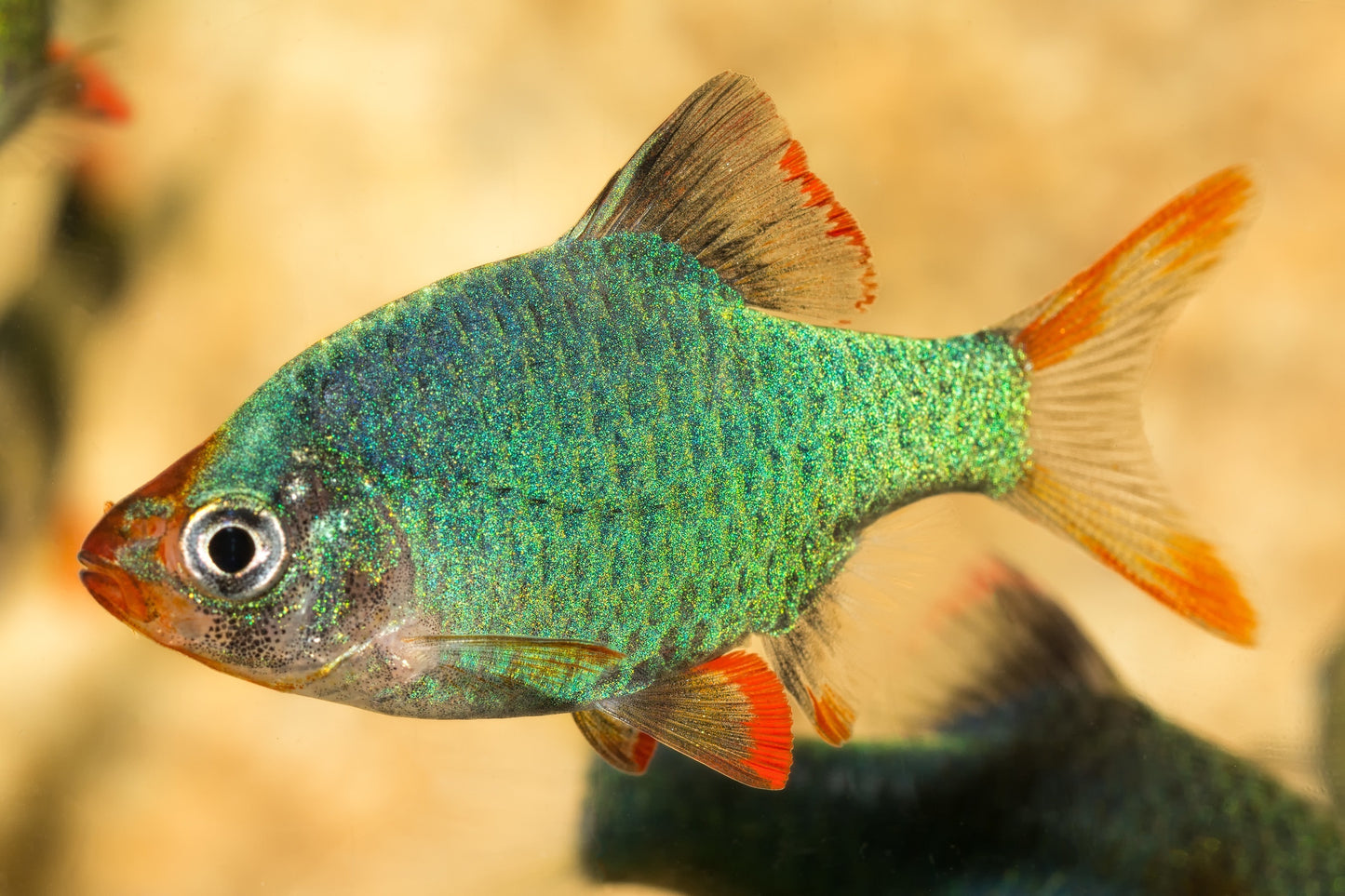Green Tiger Barb-L
$6.99 USD
Regular price
$6.99 USD
Sale price
$6.99 USD
Regular price
Unit price
/
per
Couldn't load pickup availability
Shop safely
Secure your shopping experience with various safe and trusted payment methods.
Payment methods
Sold out
The Tiger Barb, scientifically known as Puntigrus tetrazona, is a lively and colorful species of barb native to the streams and rivers of Sumatra, Borneo, and the Malay Peninsula. It is a favorite in the aquarium hobby due to its bold black vertical stripes on a bright orange to gold body, active schooling behavior, and hardiness.
Adult Tiger Barbs typically reach about 2.5 to 3 inches (6 to 7.5 cm) in length. They have a deep, laterally compressed body with four distinct black stripes running vertically across the bright orange-gold base color. The fins are tinged with red or orange, especially in healthy, well-conditioned fish. Males tend to be slimmer and display more vibrant coloration, while females are slightly larger and rounder.
A tank of at least 20 gallons is recommended for a small school. Tiger Barbs are active, social fish that should always be kept in groups of six or more to minimize fin-nipping and aggression. The aquarium should have a soft sand or fine gravel substrate, open swimming areas, and some live or artificial plants and driftwood for cover. Moderate lighting and a gentle to moderate current will help simulate their natural environment.
Water parameters for the Tiger Barb should include a temperature range of 74 to 80°F (23 to 27°C), a pH between 6.0 and 7.5, and soft to moderately hard water. They are tolerant of a wide range of conditions but thrive best in clean, well-maintained water with regular partial water changes.
Feeding Tiger Barbs is straightforward, as they are omnivorous and will accept a wide variety of foods. Offer high-quality flakes or pellets as a staple, and supplement with live or frozen foods like bloodworms, brine shrimp, and daphnia. They also appreciate some plant matter, such as blanched spinach or spirulina-based foods.
Tiger Barbs are best kept with other active, similarly sized fish such as other barbs, danios, rainbowfish, or fast-moving tetras. Avoid slow-moving or long-finned tankmates, as Tiger Barbs may nip at their fins if kept in too small a group or if bored.
Breeding Tiger Barbs is possible in captivity. They are egg-scatterers and show no parental care. To breed, use a separate tank with fine-leaved plants or spawning mops. Remove adults after spawning to prevent them from eating the eggs. Fry can be raised on infusoria or powdered foods until they are large enough to eat baby brine shrimp.
Puntigrus tetrazona (Tiger Barb) is a robust, active species that adds color and energy to community aquariums, especially when kept in large, lively groups.

Shopping Safely
At our Shopify store, we prioritize your safety and security. Here's how we ensure a secure shopping experience:
1. Secure Transactions: We use advanced encryption to protect your personal and payment information, ensuring it is safely transmitted and safeguarded.
2. Trusted Payment Gateways: Our store integrates with trusted payment gateways, ensuring your transactions are processed securely and efficiently.
3. Data Privacy: Your privacy is our top priority. We follow strict data protection policies to keep your personal information confidential and secure.
4. Secure Platform: Shopify provides robust security features and continuous monitoring against vulnerabilities, ensuring a safe shopping environment.
5. Verified Merchants: We are a verified merchant on Shopify, committed to providing authentic and high-quality products.
6. Transparent Policies: Our clear return, refund, and shipping policies provide peace of mind, knowing we stand behind our products.
7. Customer Support: Our dedicated customer support team is ready to assist with any concerns or questions you may have.
Shop confidently at our Shopify store, where your safety and satisfaction are our top priorities.
Questions about this product?
Don't be a stranger.
Selling fast!
Get yours while you can.
-
WELL TRUSTEDOver 100k customers
-
SUPER FASTWith Express delivery
-
EXPERT HELPSeven days a week
-
BEST PRICESUnbeatable value

